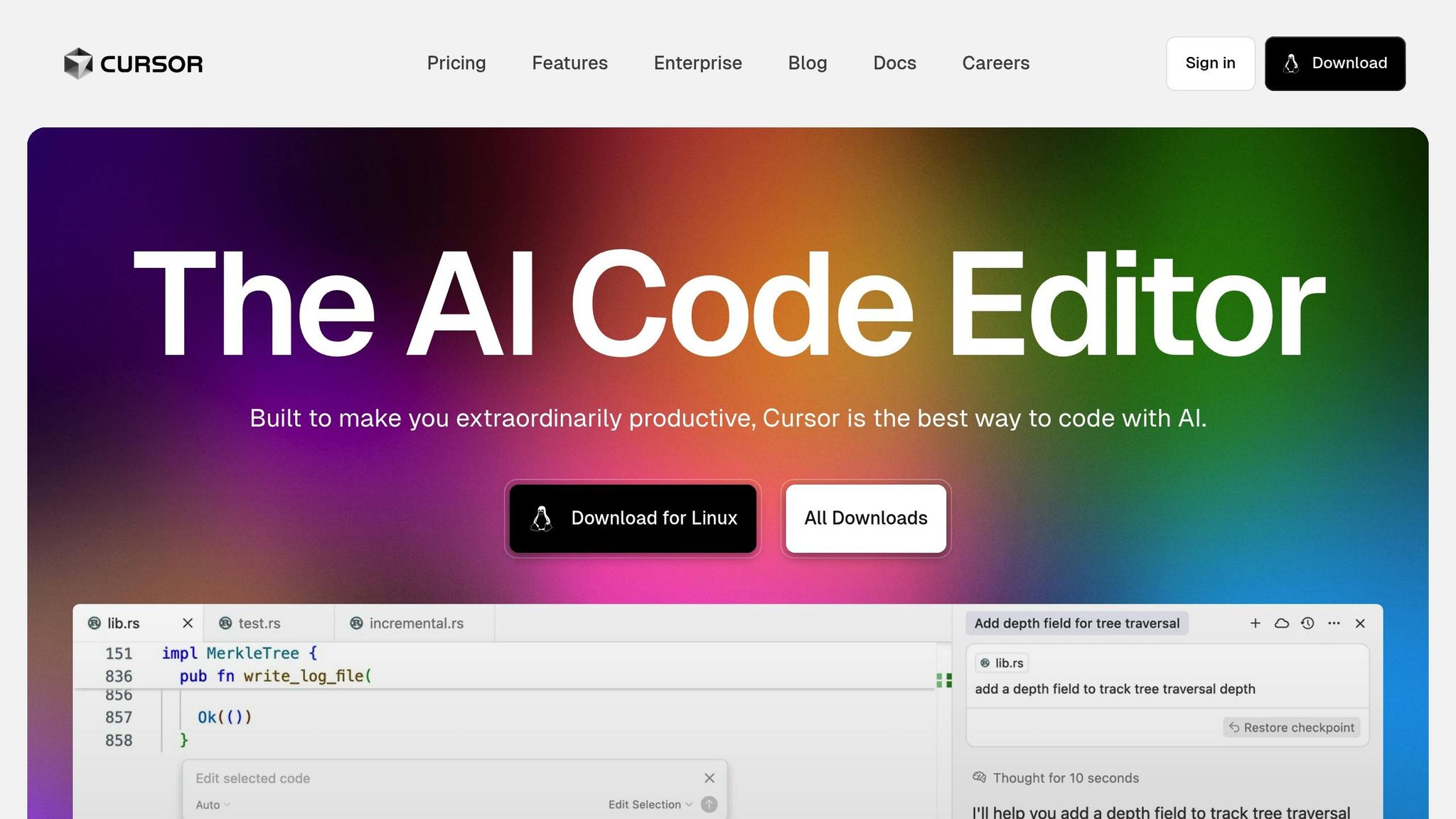In today's rapidly evolving tech landscape, efficiency is king, and Artificial Intelligence (AI) is redefining the rules of software development. One area where AI is making seismic changes is frontend development. Whether you’re a beginner exploring AI tools, a business owner looking to optimize workflows, or a seasoned creator eager to speed up your development cycles, embracing AI agents is becoming increasingly essential.
This article breaks down how AI, specifically tools like Cursor, enables faster, smarter, and more efficient frontend development. From simplifying repetitive coding tasks to streamlining the transition from design to production-ready code, we’ll explore transformative workflows and practical applications to supercharge your development process.
The AI-Powered Frontend Revolution: Why It Matters
Frontend development has traditionally been a domain requiring equal parts design sensibility and technical expertise. However, tasks that were once time-consuming - such as converting designs into code, adding functionality, or debugging complex logic - can now be expedited with AI agents.
An AI agent is essentially a large language model (LLM) operating in a loop. It generates, evaluates, and refines its output until the desired outcome is achieved. These agents free developers from mundane tasks, allowing teams to focus on high-impact problem-solving and creativity.
Let’s dive into some of the most effective ways AI agents like Cursor can transform your frontend development process.
Step 1: Understanding AI Agents and IDE Integration
What Are AI Agents?
AI agents are tools that automate development workflows through iterative processes. They analyze problems, generate solutions, and refine their outputs based on feedback or tests. Cursor’s agentic mode, for example, revolutionizes how developers interact with code, making it capable of:
- Writing functions from scratch
- Iterating through test-driven development loops
- Modifying existing code without manual intervention
- Integrating seamlessly with design tools like Figma
Why Cursor Stands Out

Cursor offers robust features designed specifically for frontend developers, including:
- A built-in "agent mode" that provides automatic context management.
- Iterative workflows where agents refine code until all test cases pass.
- Integration with popular tools like Visual Studio Code, GitHub Copilot, and Figma.
Cursor’s workflow minimizes the human effort required for repetitive coding tasks, empowering developers to shift their focus to more critical, high-level work.
Step 2: From Design to Code with AI
Automating Design Integration
One of the standout use cases for AI agents is converting designs into responsive, production-ready code. Tools like Cursor and Builder.IO specialize in bridging the gap between design and development.
Here’s a glimpse of how this works:
- Extract Design Details: AI tools analyze Figma files, including layouts, tokens, and components.
- Generate Clean Code: The AI creates modular, reusable components in your preferred framework (e.g., React, Vue, or Svelte).
- Implement Functionality: Developers can use AI to add functionality like form validation, API integration, and more.
For example, Cursor can integrate with your project’s design system to ensure that generated code follows consistent naming conventions, CSS tokens, and UI patterns.
A Practical Workflow
- Step 1: Export your Figma design using Builder.IO or a similar tool.
- Step 2: Paste the design into Cursor’s IDE or CLI to generate structured components.
- Step 3: Use AI prompts to modify code or add functionality (e.g., "Add a contact form with validation").
- Step 4: Test designs directly in your app while AI ensures fidelity between design and output.
This allows teams to iterate quickly, bringing ideas to life without sacrificing quality.
Step 3: AI-Driven Test-Driven Development (TDD)
Why TDD Matters
AI can do more than generate code - it can implement rigorous test-driven development practices. By writing test cases first, the AI ensures that the code it produces is functional and bug-free.
Here’s how it works in practice:
- Prompt the AI: Ask the AI to write test cases for your feature.
- Iterative Development: The AI generates code, runs tests, and refines the implementation until all tests pass.
- Review and Validate: Developers can review the final output to catch edge cases or apply manual refinements.
For example, if you ask Cursor to "write a function that converts Markdown to HTML, write tests first, and iterate until all tests pass", the agent will:
- Automatically write test cases.
- Write the initial function.
- Run the tests, identify failures, and revise the code.
- Continue until all tests pass.
This iterative process saves countless hours, especially on complex tasks like data parsing or API integrations.
Step 4: Enhancing Productivity with "Vibe Coding"
What Is Vibe Coding?
Vibe coding refers to a development approach where you rely on AI to handle the heavy lifting while you focus on refining and reviewing. Instead of manually crafting every line of code, developers can work iteratively with AI, responding to the "vibes" or feel of the UI.
For instance, you might use prompts like:
- "Add a subtitle under the heading."
- "Make the text blue and increase font size."
- "Add hover effects to the button."
Cursor can implement these changes in seconds, letting you iterate visually until you achieve the desired look and feel. This method is especially useful during prototyping and early-stage development.
Step 5: Managing Large Projects with AI
Scaling AI for Complex Applications
While AI works effortlessly with small or greenfield projects, larger codebases require more careful management. Here’s how to optimize AI use for big projects:
- Manual Context Management: In large repositories, specify relevant files or directories for the AI to focus on.
- Use Unit Tests: Always include test cases to verify the AI’s output and prevent regressions.
- Set Rules: Define custom rules for the AI (e.g., avoid specific libraries or enforce naming conventions).
Cursor’s YOLO mode can also automate repetitive tasks in large projects, such as refactoring functions or applying global style changes.
Key Takeaways
- AI agents like Cursor simplify frontend development by automating mundane tasks, from generating code to refining UI elements.
- Seamless integration with design tools like Figma ensures high-fidelity code production.
- Leverage test-driven development with AI to ensure bug-free code without manual effort.
- "Vibe coding" empowers creativity, letting developers focus on iterative design and functionality improvements.
- AI works equally well for beginners and advanced users, but large projects benefit from oversight, tests, and defined rules.
- AI doesn’t replace development skills - it complements and amplifies them. The more you know, the better you can guide the AI.
- Save brainpower for hard problems by letting AI handle repetitive, time-consuming tasks.
Conclusion
The advent of AI agents has undeniably transformed the frontend development landscape. By automating tedious tasks, improving design-to-code workflows, and enabling test-driven development, tools like Cursor are empowering developers to do more with less effort.
While AI simplifies many aspects of coding, it’s most powerful when combined with human oversight and expertise. As you explore these tools, remember that the goal isn’t to replace developers but to enhance their productivity, creativity, and problem-solving capabilities.
Whether you’re an experienced developer or a first-time user diving into AI tools, there’s never been a better time to embrace this technology. With the right approach, you can reduce development cycles, save brainpower, and focus on building innovative, user-centric applications.
Source: "AI Powered Frontend Development: Building Better UIs" - Builder, YouTube, Sep 3, 2025 - https://www.youtube.com/watch?v=X406gPfof1E
Use: Embedded for reference. Brief quotes used for commentary/review.



